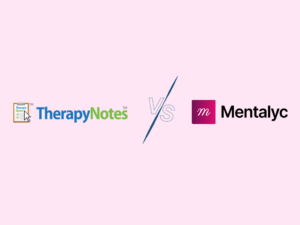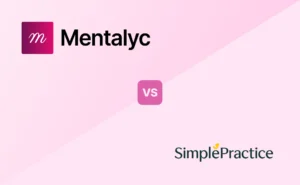What Are Therapy Notes and How to Write Them?
Your last session ran over time, you are making sure your patient is wearing the broadest smile, feeling supported, and having all his questions answered; tens of patients are still waiting for your consultation; you have a pile of client emails that need an answer, and you need to grab some lunch before your upcoming appointment. You end up scribbling down some rushed therapy notes and then spend the evening trying to decipher your handwriting and remember the details. Sounds familiar, right?
Almost all therapists know how valuable it is to take therapy notes. Those are of utmost importance as they function as a roadmap to keep track of your patient’s progress and adjust your treatment plans to meet their goals. But all therapists also know how arduous it is to write therapy notes that capture all the required information in a concise, organized, and efficient form that can subsequently act as stepping stones for you to reference.
This article will guide you on how to effectively write therapy notes after outlining the different note types and templates available. You will be provided with our top recommendations for excellent record keeping, which can keep you organized while saving you time and ensuring you meet requirements for relevant standards and regulations.
What are mental health therapy notes?
Therapy notes are a therapist’s private record of their patient encounters. These are the notes that a mental health professional writes down as you talk during your therapy session. They are the provider’s private thoughts, meant to keep track of what happened at each appointment, document the clinician’s thoughts, impressions, and feelings about the conversation along with vital details and topics to be pursued, and develop a clearer picture of the problems and experiences that the client is dealing with.

New! Transfer your notes to EHR with a single click. No more copy-pasting.
HIPAA (Health Insurance Portability and Accountability Act) defines therapy notes as any note in any form used to document or analyze the contents of conversations that occur during individual, group, family, or joint counseling sessions.
These notes naturally contain sensitive information. That is the reason, unlike other medical records, therapy notes are subject to special protection and are kept confidential. That is, they do not appear in medical records and cannot be shared with a third party except with the patient’s written consent. HIPAA regulations require that therapy notes be stored separately. They can be kept in a locked filing cabinet or stored on a digitally password-protected computer, but the therapist should be the only one to access them.
Examples of Therapy Notes
When dealing with a patient, therapists and other mental health professionals have a series of responsibilities. These include not only listening to the patient and making sure he does not feel unsupported and alone but also taking note of patterns and notable details that could be of utmost importance: a subject matter that is constantly brought up, how a patient chooses to articulate themselves, and more.
While the content of such notes is variable depending on their particular purpose, they can generally be classifiable into two broad categories: progress notes and psychotherapy notes, which serve different purposes and are structured and written differently.
Before holding our discussion of therapy notes, a distinction will be made between progress notes and psychotherapy notes.
Progress Notes
In a nutshell, progress notes serve to document the progress of treatment, as the name implies. They include information about the presenting symptoms, diagnosis, medications, treatment modalities, results of psychological tests, and prognosis and are usually briefer and more limited in terms of their scope. This is because these notes’ information might be -under certain circumstances- shared with other service providers and insurance companies, or the clients themselves upon special request.
Psychotherapy Notes
On the other hand, therapy notes, the focal point of this article, are much more detailed. Think of therapy notes as a personal record for therapists. To elaborate, psychotherapy notes are more in-depth, private notes meant to help your therapist log their clinical impressions, prepare for future sessions, and make detailed hypotheses during sessions in order to get a fuller picture of your situation.
Distinguishably, psychotherapy notes exclude medication prescription and monitoring, counseling session starts and stops times, the modalities of treatment furnished, the results of clinical tests, and the prognosis and progress to date.
Noteworthy is that such notes may contain sensitive information that stands out to the therapist and that is not to be shared with others outside the therapeutic relationship, the reason they are subject to a greater degree of privacy and confidentiality: under HIPAA laws, people do not have a right to access their therapy notes. Even when patients request access, the healthcare professional is under no obligation to share his notes.
Writing Therapy Notes

As a therapist, writing therapy notes is one of the most important parts of your career. From the first glance at your patient, until they reach their therapeutic goals, your notes are paving stones for you to reference. Failing to follow best practices for therapy notes can have professional repercussions complicating your clinical life, the reason it is important to know how to get your notes done quickly but accurately and efficiently.
1. Write clear, easy-to-understandable notes
Unlike progress notes, therapy notes are not meant to be shared with other care providers. But they do have an audience: you as a provider. That is why of utmost importance is to master the art of writing effective notes that are clear enough for your future self, who may not recall the session in detail.
2. Be selective, clear, and concise
If you were to write down every observation or thought during the session, your notes would never come to an end. Try to be straight to the point and include only what is relevant. Understand what you are looking for: know very well what a perfect document or note looks like to your future self and try to get as close as possible to it. What information do you need about your patients and the session to create a treatment plan for them? What information is specifically useful and helpful? Write information that you can actually use.
3. Familiarize yourself with the HIPAA requirements
Use your critical thinking skills to assess the situation from every angle, elaborate on your feelings and opinions in your notes, read your notes before each session to refresh your memory, and avoid using slang, jargon, or too many abbreviations that could confuse you later on. Be careful not to use overly positive or negative phrasing in your notes as you can end up with judgmental notes.
4. Ensure data security
Keep your notes separate from others and maintain confidentiality by password-protecting your documents or storing them in a very secure manner as they contain overly sensitive personal data about your patient.
5. Use simple note-taking templates
Ready templates can make the note-taking process effective, quick, and easy, and keep things organized while ensuring that you include all relevant information. There are plenty of formats available to choose from: S.O.A.P., B.I.R.P., and D.A.P. are the most common templates for psychotherapy note-taking. Worth noting is that there’s no one-size-fits-all template for writing therapy notes. Choose the one that you feel is the best fit for your needs.
You can also consider streamlining your therapy notes with Mentalyc’s versatile platform, designed to support a wide range of therapeutic approaches and modalities. Ensure accurate, effective documentation that enhances client outcomes and saves time.
Therapy Note Templates
S.O.A.P. Notes
Here is what each section of your SOAP notes should contain:
- Subjective: The subjective section includes the patient’s concerns, feelings, and history of illness in their own words. Document your patient’s condition based on the descriptions they give you about why they decided to seek therapy.
- Objective: Include your notes on the client’s appearance, body language, and any other notable detail that grasp your attention during the session.
- Assessment: During the assessment, healthcare professionals provide diagnoses.
- Plan: Document your plan by describing the actions to be followed to ensure your patient meets his therapeutic goals.
See an example of a SOAP note (not a real session) generated with the Mentalyc AI progress note generator software below:
SUBJECTIVE
Presentation
- Chief Complaint: The client presented with a depressed mood, low motivation, loneliness, and difficulty connecting with others.
- Quote (Chief Complaint): “I don’t know, some days I’m just feeling horrible.”
- Impairments And Challenges: The client described impairments in motivation, engagement in previously enjoyed activities like making music, and establishing meaningful relationships. Their isolation and loneliness appeared to exacerbate their depression.
- Quote (Impairments And Challenges): “I just feel so miserable.”
Psychological Factors:
- Symptom 1:
- Symptom Description: Depressed mood most of the day, nearly every day.
- Onset: Ongoing, no specific onset provided.
- Frequency: Daily.
- Ascendance: No improvements reported.
- Intensity: Moderate to severe.
- Duration: Several years per client report.
- Quote (Symptom): “I’m always seeing things I know I can’t do. It feels heavy.”
- Symptom 2:
- Symptom Description: Low motivation and withdrawal from previously enjoyable activities.
- Onset: Gradual, no specific onset provided.
- Frequency: Daily.
- Ascendance: No improvements reported.
- Intensity: Moderate to severe lack of motivation.
- Duration: Several years per client report.
- Quote (Symptom): “I just go places where there’s no one and sit there alone.”
OBJECTIVE Clinical Assessment:
- Assessment Tool: Clinical Interview
- Results: Read above.
- Status: Ongoing
Risk Assessment:
- Risks Or Safety Concerns: No risks or safety concerns identified.
Interventions:
- Therapeutic Approach Or Modality: Cognitive-behavioral therapy, interpersonal therapy
- Psychological Interventions:
- Validated feelings.
- Encouraged challenge of automatic thoughts.
- Assigned thought tracking.
- Rationale: Increase awareness of cognitive distortions fueling depression. Begin the process of identifying and challenging automatic negative thoughts.
ASSESSMENT Progress And Response:
- Response To Treatment: The client displayed limited engagement and motivation for change.
- Specific Examples Or Instances: Client keeps deflecting from talking about certain issues.
- Quote (Progress): “I don’t know, I don’t think I can.”
- Challenges To Progress: Lack of motivation and avoidance of social connections will likely impede progress. Negative automatic thoughts and cognitive distortions will also pose a challenge.
- Therapist Observations And Reflections: Client is fused with their negative thoughts, might need to introduce defusion techniques.
- Therapeutic Alliance: The client showed some resistance. She was hesitant to talk about certain things related to her anxiety. The therapist processed that with her.
PLAN Follow-Up Actions And Plans:
- Homework: Complete thought records identifying automatic negative thoughts and labeling cognitive distortions. Engage in one social activity.
- Plan For Future Session: Review thought records, continue cultivating motivation and self-efficacy, begin discussing behavioral activation steps.
- Plans For Continued Treatment: Continue weekly therapy, consider psychiatric referral if lack of progress.
- Coordination Of Care: No coordination of care indicated at this time.
B.I.R.P. Notes
- Behavior: Note your impressions of your patient by creating behavioral notes from the patient’s statements and your observations as a therapist.
- Intervention: Focus on what methods it takes to reach the patient’s therapeutic goal.
- Response: This is where you record how the patient reacts to interventions.
- Plan: The plan outlines the next steps in the treatment.
Here’s an example of a BIRP note generated by Mentalyc AI:
BEHAVIOR
Psychological Factors:
- Symptom 1:
- Symptom Description: Depressed mood most of the day, nearly every day.
- Onset: Ongoing, no specific onset provided.
- Frequency: Daily.
- Ascendance: No improvements reported.
- Intensity: Moderate to severe.
- Duration: Several years per client report.
- Quote (Symptom): “I’m always seeing things I know I can’t do. It feels heavy.”
- Symptom 2:
- Symptom Description: Low motivation and withdrawal from previously enjoyable activities.
- Onset: Gradual, no specific onset provided.
- Frequency: Daily.
- Ascendance: No improvements reported.
- Intensity: Moderate to severe lack of motivation.
- Duration: Several years per client report.
- Quote (Symptom): “I just go places where there’s no one and sit there alone.”
Therapist Observations And Reflections: The client displays cognitive distortions like mental filtering that focus on negative aspects of situations. Increased awareness of these patterns through thought tracking will be beneficial. The client requires support and encouragement to challenge avoidance behaviors.
INTERVENTIONS
- Therapeutic Approach Or Modality: Cognitive-behavioral therapy, interpersonal therapy
- Psychological Interventions:
- Validated feelings.
- Encouraged challenge of automatic thoughts.
- Assigned thought tracking.
- Rationale: Increase awareness of cognitive distortions fueling depression. Begin the process of identifying and challenging automatic negative thoughts.
RESPONSE
Progress and Response:
- Response To Treatment: The client displayed limited engagement and motivation for change.
- Specific Examples Or Instances: Client keeps deflecting from talking about certain issues.
- Quote (Progress): “I don’t know, I don’t think I can.”
- Challenges To Progress: Lack of motivation and avoidance of social connections will likely impede progress. Negative automatic thoughts and cognitive distortions will also pose a challenge.
- Therapist Observations And Reflections: Client is fused with their negative thoughts, might need to introduce defusion techniques.
- Therapeutic Alliance: The client showed some resistance. She was hesitant to talk about certain things related to her anxiety. The therapist processed that with her.
PLAN Follow-Up Actions And Plans:
- Homework: Complete thought records identifying automatic negative thoughts and labeling cognitive distortions. Engage in one social activity.
- Plan For Future Session: Review thought records, continue cultivating motivation and self-efficacy, begin discussing behavioral activation steps.
- Plans For Continued Treatment: Continue weekly therapy, consider psychiatric referral if lack of progress.
- Coordination Of Care: No coordination of care indicated at this time.
D.A.P. Notes
DAP notes focus on Data, Assessment, and Plan.
- Data: This is where you document your observations and descriptions of the patient.
- Assessment: Once you note relevant observations, use this section to document what these behaviors mean.
- Plan: The last section in DAP notes is where you will note follow-up instructions for your patient and possible therapeutic interventions for the future.
Final Thoughts
Note-taking is the heart of clinical documentation and in many ways the most important clinical skill to master, because it provides the clearest record of what happens behind closed doors, rendering appropriate and necessary medical services.
Mentalyc health professionals can also achieve faster, more accurate therapy notes with Mentalyc’s HIPAA-compliant, SOC 2 Type 2 compliant platform. With customizable templates built specifically for us, Mentalyc simplifies documentation and supports better outcomes—so you can focus on what matters most.
References
- Cornell Law School. 45 CFR § 164.501 – Definitions.
- Department of Health & Human Services. HIPAA Administrative Simplification. Regulation text 45 CFR Parts 160,162, and 164.
Why other mental health professionals love Mentalyc

“By the end of the day, usually by the end of the session, I have my documentation done. I have a thorough, comprehensive note … It’s just saving me hours every week.”
CDCII

“It takes me less than 5 minutes to complete notes … it’s a huge time saver, a huge stress reliever.”
Licensed Marriage and Family Therapist

“A lot of my clients love the functionality where I can send them a summary of what we addressed during the session, and they find it very helpful and enlightening.”
Therapist

“Having Mentalyc take away some of the work from me has allowed me to be more present when I’m in session with clients … it took a lot of pressure off.”
LPC






